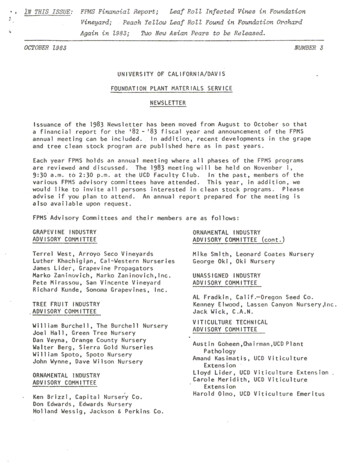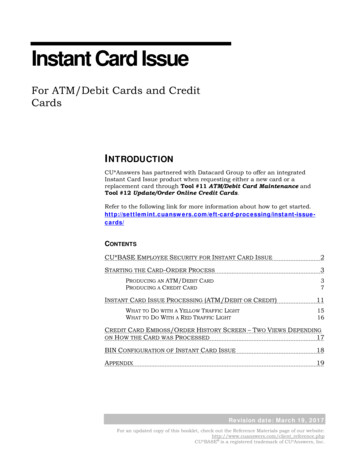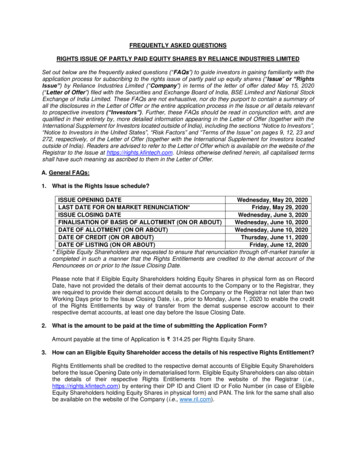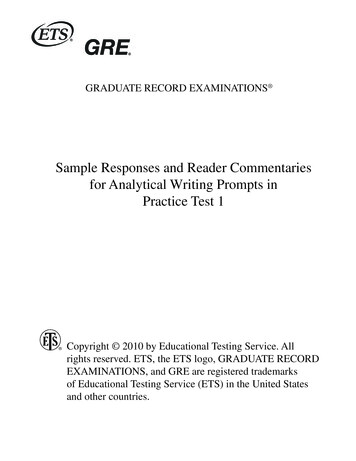
Transcription
.iN THIS ISSUE :FPMS Financial Repo1,,t;Vineyard;Leaf Roll Infected Vines in FoundationPeach Yellow Leaf Roll Found in Foundation Orchard/!gain in l98 3 ;Two New Asian Pears to be Re leas ed .OCTOBER l983NUMBER 3UNIVERSITY OF CALIFORNIA/DAV ISFOUNDATION PLANT MATERIALS SERVICENEWSLETTERIssuance of the 1983 Newsletter has been moved from Augus t to October so thata financial report for the 1 82 - 1 83 fiscal year and announcement of the FPMSannual meeting can be inc l uded. In addition, recent developments in the grapeand tree clean stock progr am are published here as in past years.Each year FPMS holds an annual meeting where all phases of the FPMS programsare reviewed and discussed. The 1983 meeting wil 1 be held on Novembe r 1,9:30 a.m. to 2:30 p.m. at the UCD Faculty Club. In · the past, members of thevarious FPMS advisory committees have attended. This year, in addition, wewould 1 ike to invite all persons interested in clean stock programs. Pleaseadvise if you plan to attend. An annual report prepared for the meeti.ng isalso available upon request.FPMS Advisory Committees and their members are as follows:GRAPEVINE INDUSTRYADVISORY COMMITTEEORNAMENTAL INDUSTRYADVISORY COMMITTEE (cont.)Terrel West, Arroyo Seco VineyardsLuther Khachigi n, Cal-Western NurseriesJames Lide r , Grapevine PropagatorsMarko Zanin ovich, Marko Zan i novich,lnc.Pete Mirassou, San Vincen t e VineyardRichard Kunde, Sonoma Gr apevines, Inc.Mike Smith, Leonard Coates NurseryGeorge Oki, Oki NurseryTREE FRUIT INDUSTRYADVISORY COMMITTEEWilliam Burchell, The Burc hell NurseryJoel Hall, Green Tree NurseryDan Veyna, Orange County NurseryWalter Berg, Sierra Gold NurseriesWilliam Spoto, Spoto NurseryJohn Wynne, Dave Wilson NurseryORNAMENTAL INDUSTRYADVISORY COMMITTEEKen Br i z z i , Cap i ta l Nu rs e r'y Co .Don Edwards, Edwards NurseryHolland Wessig, Jackson & Perkins Co.UNASSIGNED INDUSTRYADVISORY COMMITTEEAL Fradkin , Calif.-Oregon Seed Co.Kenney Elwood, Lassen Canyon Nursery,lnc.Jack Wi ck, C.A.N.VITICULTURE TECHNICALADVISORY COMMITTEEAustin Goheen,Oiairman , UCO PlantPathologyAmand Kasimatis, UCO ViticultureExtensionLloyd Lider, UCO Vi t iculture ExtensionCarole Meridith, UCO Viticultu eExtensionHarold Olmo, UCO Viticultu r e Emeritus
PAGE 2NEWSLETTERPOMOLOGY TECHNICALADVISORY COMMITTEEORNAMENTAL TECHNICALADVISORY COMMITTEEJim Beutel, Chairman, UCO Pomology ExtensionDale Kester, uco · PomologyGeorge Nyland, UCO Plant PathologyRaymond Hasek, Chairman, UCOEnvironmental Horti ultureAndrew Leiser, UCD EnvironmentalHorticultureEnclosed with this newsletter for your use is a current FPMS order form, price andmaterials list. Please note that available materials are allocated among all whoorder by the appropriate deadline. After that it is sold on a first come, firstserve basis. Final dates for the various materials are as follows:To be included in allocation, order· must be received no later than:Grape MaterialRose Rootstock OrdersFruit & Nut TreewoodSeed Orders(including Betulaefolia fruit) INANCIALNovember 15October 28December 1July 15REPORTrotal income for FPMS in the 1982-83 fiscal year amounted to 129,819.52;· Totalexpenditures were 138,051.28 leaving a deficit for the year of 8,231 .76. This isthe first time in 3 years that FPMS has had a net deficit. It is most 1 ikely areflection of the temporary slow down of the California nursery industry in general.In 1982-83 119,574 grape cuttings, graftsticks and budsticks were sold. Also 5,9831buds, and 7,986 cuttings of fruit and nut tree material as well as 70, 180 certifiedpeach seeds, 446.S pounds certified plum and cherry seed, and 426.5 pounds ofBetulaefol ia fruit were sold. Of Rose material FPMS sold 17,960 rootstock cuttings,and 4,670 scion buds.All ·plantmaterial sold by FPMS (except patented material and for cherry, peach,plum and potato seed) is covered by a grower agreement contract. All customers arerequired to sign it when ordering material (on reverse side of order form). Thecontract states that the grower agrees to pay FPMS 2 /propagative unit from saidmaterial which is sold, exchanged or retained by the grower. This means that if acustomer buys a cutting from FPMS, produces a plant (generation A) and then sometimein the future takes a propagat i ve unit from that plant to sell or use him/herselfto produce a 2nd plant (generation B) then the customer will pay to FPMS 2 for eachpropagative unit sold, used or exchanged, as per the. i l lustration following:
PAGE 3NEWSLETTERGRAPEVINE USER r:EEE;I------).XA fv1P L Soldto Cvstome,.)(ttc'13frornC\IFPMS) 4-/propQsQthte "'"itsold 1 vsed or B)(chan9ed:to f PMS on Ma I .9rQ pev n e.(GENE Anot-l B)User fees are a major source of revenue for FPMS. They. were instituted to helpoffset the high cost of producing small quantities of many types and varieties ofplant material. In 1982-83 14,405.69 in user fees were collected for grape 6,613.49 for fru i t and nut trees and 680.00 for roses.PLANT PATHOLOGY REPORT FOR FRUIT TREE PROGRAM each Yellow Leaf Roll has once again been found in the Foundation Orchard.trees found to be infected are:VarietyAccession#TwoLocationLove 1110-34-1-63NFO C8T817, 16-2110-151-1-78NFO Q6T9The California State Department of Food & Agriculture will most likely have tosuspend registration on all peach and nectarine material in the orchard according topresent regulations for at least one year.This is the 3rd time in 5 years Peach Yellow Leaf Roll has moved into the FoundationOrchard. Meetings between the University and C l ifornia State Department of Food &Agriculture will soon be underway to discuss this situation. Changes may need to bemade in the State regulations or in the way peach material is maintained because ofthe disease.PLANT PATHOLOGY REPORT FOR GRAPE VINE PROGRAMAll California registered grape material maintai·ned by FPMS has been indexed fordisease before inclusion in the Foundation vineyard. Also, in compliance with Stateregulations, the vines are all inspected twice annually while growing. When new indexing procedures to detect disease more accurately are developed every effort is made by
PAGE 4 NEWSLETTERFPMS and the UCD Plant Pathology Department to recheck registered vines using newprocedures. This happened in 1981 when 41 selections were removed from registrationbecause they were found to be infected with stem pitting. Also, in Spring 1983,tests were completed on selected registered varieties using Cabernet franc as anindicator. Cabernet franc has been recently found to be a very sensitive leaf rollindicator. Test results showed 7 registered selections to be infected with leaf rollas follows:PerletteSauvignon blancThompson SeedlessBeauty SeedlessGringnolinoPinot NoirPinot NoirlA3lA213A21All these above selections were removed from the Registration and CertificationProgram. One hundred eleven other selections (including all registered rootstockvarieties) indexed for leaf roll in Cabernet franc at the same time were found to behealthy. For a complete list of all selections that tested healthy on Cabernetfranc and/or all selections that tested positive for stem pitting in 1981 write toFPMS.NEW PROJECTSMS has recently acquired additional land on the University Farm thatwill be used to plant a new Foundation Vineyard and Betulaefolia pear seed trees.Much of the current Foundation Vineyard was planted 20 years ago and is starting toshow decline from Eutypa. Establishing a new vineyard will provide the opportunityto better organize the planting and use wider spacing. Plantings of peach, plumand cherry seed trees have also been extended in our present Foundation Orchard.This should result in an improved supply and quality of wood and seed for ourcustomers.A committee of members from FPMS and the Department of Viticulture has recently beenestablished to study the identity of several California grape varieties. A vineyardwas set up in the Viticulture Department to compare vines of approximately 15important California varieties side by side with suspected European counterparts. Assoon as the vines fruit val id comparisons will be made.Among several thousand named varieties of fruits and grapes in t he world, it iseasy . to see that variety mixes might occur. When variety mixes are discovered theyshould be corrected as soon as possible for the good of the industry. FPMS attemptsto have all our plant material examined for trueness to type before it is distributed.It is, however, still very important for anyone receiving our material to examine itfor identification and report back any discrepancies to FPMS. We would also appreciatereceiving any evaluation reports on the various selections sold.
NEWSLETTERPAGE 5Sometime within the next 30 days FPMS wil 1 be installing a computer. We plan touse it to store records, keep an inventory of materials available, process orders,do mailings, etc. This should g r eatly facilitate answering customers' questions.Two new Asian Pear varieties, 12-43 and 12-44, will be patented by University ofCal ifornia for release fo r nursery budding by summer 1984. Both selections are theresult of a cross betvJeen Ki kusu i (20th Century type) and Tsu Li (pear shapedChinese pear). Both selections make good sized trees on Winter Nel is rootstock,while P. Betulaefolia rootstoc k makes huge trees. Both ripen in Sep t ember and canbe stored at 32 degrees F. for many months. Fruit color is green. Size exceeds3 inches in diameter even when only 1 ightly thinned. Crop of 150-200 pounds pertree is possible at 8 years, wh i ch is equal or better than any Asian pear.Selection 12-43 is slightly flat (1 ike Rome Beauty apple) with short stem. It hasa fine textured f l esh that is sweet to taste. The skin tends to russet if rainis heavy during b l oom. Fruit size is good.Selection 12-44 i s very large (larger than 12-43) 3 - 4 inches in diameter and isshaped like a Cornice pear. It has deep green skin with little or no russet. Thestem is short and less stiff than Cornice stem. Flesh is firm, juicy and remainssweet and fresh t asting for more than 6 months of common 32 degree F. storage.Both varieties bloom with Choju r o and slightly ahead of 20th Century. Fruit setis not a problem but pol l en compatibility with other varieties and each otherneeds more study which should be done in Spring of 1984.Selections will be given Asian names but final decisions have not been made atthis time.
Each year FPMS holds an annual meeting where all phases of the FPMS programs are reviewed and discussed. The 1983 meeting . Jim Beutel, Chairman, UCO Pomology Extension Dale Kester, uco · Pomology . sweet and fresh t asting for more than 6 months of common 32 degree F. storage. Both varieties bloom with Chojuro and slightly ahead of 20th .










